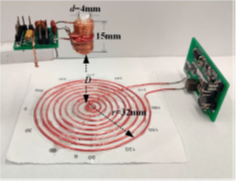

Miniaturized Radio-Frequency Transceiver
University of Pittsburgh researchers with partners from eWear Technologies LLC, and academics from China, have developed a novel miniaturized radio-frequency transceiver (mRFT) that can power implanted medical devices from outside the body through wireless power transfer (WPT) and wirelessly communicate data to and from these devices. This mRFT could lead to the development of smaller implantable medical devices (i.e., microimplants) and remove the need for surgical intervention to replace batteries.

Description
Microimplants are increasingly used in modern medicine, from nerve stimulators to pacemakers and drug delivery systems. These devices improve the quality of life of millions of people globally. By 2030, the global market for medical devices is expected to exceed $130bn. A major challenge in the design of microimplants is the development of novel methods to communicate data to (i.e., downlink) and from (i.e., uplink) a device. While WPT can deliver power transcutaneously to a device, medical devices also need to wirelessly communicate data. Traditionally this required a separate data link to avoid interference with the WPT source, demanding space and electrical power – resources already limited in microimplants. To overcome this, a dual function mRFT has been developed using a shared coil with three connection points, which requires less space and power and could revolutionize efforts to further miniaturize medical devices.Applications
• MicroimplantsAdvantages
While WPT has been explored to power microimplants, removing the need for a main battery, challenges around miniaturizing data communication to and from medical devices remains. Downlink data communications can be achieved easily as data transfer is in the same direction as WPT, but uplink where the flow of energy is in the opposite direction to WPT has been extremely difficult. One approach, load-shift keying (LSK) uplink integrated with the WPT system can transmit data through changes in the capacitive load of the WPT but is ineffective over large transmission distances and when implants are deep within the body. This novel mRFT is designed as a shared coil capable of both power and data transfer. Using a harvesting-then-transmitting strategy, a portion of energy received by the WPT circuit is stored in a relatively large capacitor. Data is transferred by a quick discharge of the capacitor to a passive circuit which converts the DC energy to a high voltage oscillatory signal at the resonant frequency of the WPT circuit, resulting in data transmission to a coil outside the body.Invention Readiness
A prototype circuit has been produced. Testing demonstrated this mRFT could produce uplink signals 15 times stronger than existing LSK technology. Further work is required to optimize this device and assess biosafety.IP Status
https://patents.google.com/patent/US20240048184A1Related Publication(s)
Sun, M., Xu, Q., Wang, T., Mao, S., Justin, G. A., Jia, W., & Mao, Z.-H. (2021). Wireless Power Transfer And Data Communication For Low-Power Micro Electronic Devices Deeply Implanted Within The Human Body. IEEE/ACM International Symposium on Low Power Electronics and Design (ISLPED). https://doi.org/10.1109/islped52811.2021.9502502
Wang, T., Xu, Q., Jia, W., Mao, Z.-H., Tang, H., & Sun, M. (2021). Dual-Functional Wireless Power Transfer and Data Communication Design for Micromedical Implants. IEEE Journal of Emerging and Selected Topics in Power Electronics, 9(5), 6259–6271. https://doi.org/10.1109/jestpe.2021.3049787